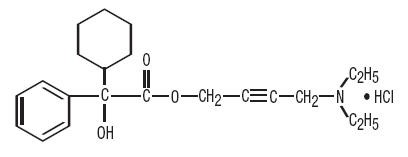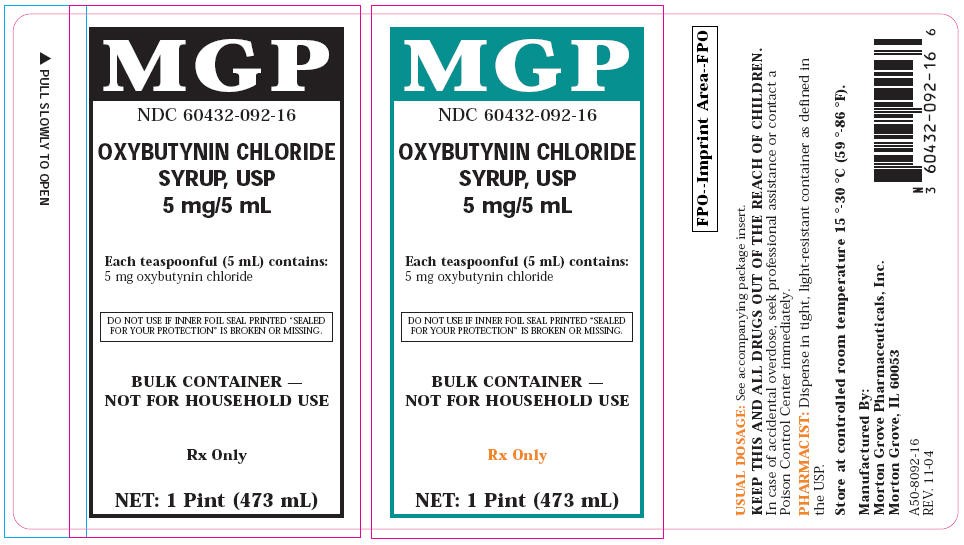Oxybutynin Chloride
Morton Grove Pharmaceuticals, Inc.
OXYBUTYNIN CHLORIDE SYRUP, USP 5 mg/5 mL
FULL PRESCRIBING INFORMATION: CONTENTS*
- OXYBUTYNIN CHLORIDE DESCRIPTION
- CLINICAL PHARMACOLOGY
- OXYBUTYNIN CHLORIDE INDICATIONS AND USAGE
- OXYBUTYNIN CHLORIDE CONTRAINDICATIONS
- WARNINGS
- PRECAUTIONS
- OXYBUTYNIN CHLORIDE ADVERSE REACTIONS
- OVERDOSAGE
- OXYBUTYNIN CHLORIDE DOSAGE AND ADMINISTRATION
- HOW SUPPLIED
- PRINCIPAL DISPLAY PANEL - 473 mL Bottle Label
FULL PRESCRIBING INFORMATION
OXYBUTYNIN CHLORIDE DESCRIPTION
Chemically, oxybutynin chloride is 4-(Diethylamino)-2-butynyl (±)-α-phenylcyclohexaneglycolate hydrochloride. The molecular formula of oxybutynin chloride is C22H31NO3•HCl. The structural formula appears below:

Oxybutynin chloride is a white crystalline solid with a molecular weight of 393.96. It is readily soluble in water and acids, but relatively insoluble in alkalis.
Each 5 mL, for oral administration, contains 5 mg of oxybutynin chloride. In addition, the following inactive ingredients are present: Artificial raspberry flavor; citric acid, USP; D&C Yellow No. 10; FD&C Blue No. 1; glycerin, USP; liquid sugar; methylparaben, NF; propylene glycol, USP; sodium citrate, USP and sorbitol solution, USP.
Therapeutic Category: Antispasmodic, anticholinergic.
CLINICAL PHARMACOLOGY
Oxybutynin chloride exerts direct antispasmodic effect on smooth muscle and inhibits the muscarinic action of acetylcholine on smooth muscle. Oxybutynin chloride exhibits only one fifth of the anticholinergic activity of atropine on the rabbit detrusor muscle, but four to ten times the antispasmodic activity. No blocking effects occur at skeletal neuromuscular junctions or autonomic ganglia (antinicotinic effects).
Oxybutynin chloride relaxes bladder smooth muscle. In patients with conditions characterized by involuntary bladder contractions, cystometric studies have demonstrated that oxybutynin chloride increases bladder (vesical) capacity, diminishes the frequency of uninhibited contractions of the detrusor muscle, and delays the initial desire to void. Oxybutynin chloride thus decreases urgency and the frequency of both incontinent episodes and voluntary urination.
Oxybutynin chloride was well tolerated in patients administered the drug in controlled studies of 30 days duration and in uncontrolled studies in which some patients received the drug for 2 years. Pharmacokinetic information is not currently available.
OXYBUTYNIN CHLORIDE INDICATIONS AND USAGE
Oxybutynin chloride syrup is indicated for the relief of symptoms of bladder instability associated with voiding in patients with uninhibited neurogenic or reflex neurogenic bladder (ie, urgency, frequency, urinary leakage, urge incontinence, dysuria).
OXYBUTYNIN CHLORIDE CONTRAINDICATIONS
Oxybutynin chloride is contraindicated in patients with untreated angle closure glaucoma and in patients with untreated narrow anterior chamber angles since anticholinergic drugs may aggravate these conditions.
It is also contraindicated in partial or complete obstruction of the gastrointestinal tract, paralytic ileus, intestinal atony of the elderly or debilitated patient, megacolon, toxic megacolon complicating ulcerative colitis, severe colitis, and myasthenia gravis. It is contraindicated in patients with obstructive uropathy and in patients with unstable cardiovascular status in acute hemorrhage.
Oxybutynin chloride is contraindicated in patients who have demonstrated hypersensitivity to the product.
WARNINGS
Oxybutynin chloride, when administered in the presence of a high environmental temperature, can cause heat prostration (fever and heat stroke due to decreased sweating). Diarrhea may be an early symptom of incomplete intestinal obstruction, especially in patients with ileostomy, or colostomy. In this instance treatment with oxybutynin chloride would be inappropriate and possibly harmful.
Oxybutynin chloride may produce drowsiness or blurred vision. The patient should be cautioned regarding activities requiring mental alertness such as operating a motor vehicle or other machinery or performing hazardous work while taking this drug.
Alcohol or other sedative drugs may enhance the drowsiness caused by oxybutynin chloride.
PRECAUTIONS
Oxybutynin chloride should be used with caution in the elderly and in all patients with autonomic neuropathy, hepatic or renal disease. Oxybutynin chloride may aggravate the symptoms of hyperthyroidism, coronary heart disease, congestive heart failure, cardiac arrhythmias, hiatal hernia, tachycardia, hypertension, and prostatic hypertrophy.
Administration of oxybutynin chloride to patients with ulcerative colitis may suppress intestinal motility to the point of producing a paralytic ileus and precipitate or aggravate toxic megacolon, a serious complication of the disease.
Carcinogenesis, Mutagenesis, Impairment of Fertility
A 24-month study in rats at dosages up to approximately 400 times the recommended human dosage showed no evidence of carcinogenicity.
Oxybutynin chloride showed no increase of mutagenic activity when tested in Schizosaccharomyces pompholiciformis, Saccharomyces cerevisiae and Salmonella typhimurium test systems. Reproduction studies in the hamster, rabbit, rat, and mouse have shown no definite evidence of impaired fertility.
Pregnancy
Teratogenic Effects-Pregnancy Category B
Reproduction studies in the hamster, rabbit, rat, and mouse have shown no definite evidence of impaired fertility or harm to the animal fetus. The safety of oxybutynin chloride administered to women who are or who may become pregnant has not been established. Therefore, oxybutynin chloride should not be given to pregnant women unless, in the judgment of the physician, the probable clinical benefits outweigh the possible hazards.
Nursing Mothers
It is not known whether this drug is excreted in human milk. Because many drugs are excreted in human milk, caution should be exercised when oxybutynin chloride is administered to a nursing woman.
Pediatric Use
The safety and efficacy of oxybutynin chloride administration have been demonstrated for pediatric patients 5 years of age and older (see DOSAGE AND ADMINISTRATION ). However, as there is insufficient clinical data for pediatric patients under age 5, oxybutynin chloride is not recommended for this age group.
OXYBUTYNIN CHLORIDE ADVERSE REACTIONS
Following administration of oxybutynin chloride, the symptoms that can be associated with the use of other anticholinergic drugs may occur:
Cardiovascular: Palpitations, tachycardia, vasodilatation
Dermatologic: Decreased sweating, rash
Gastrointestinal/Genitourinary: Constipation, decreased gastrointestinal motility, dry mouth, nausea, urinary hesitance and retention
Nervous System: Asthenia, dizziness, drowsiness, hallucinations, insomnia, restlessness
Ophthalmic: Amblyopia, cycloplegia, decreased lacrimation, mydriasis
Other: Impotence, suppression of lactation
OVERDOSAGE
The symptoms of overdosage with oxybutynin chloride may be any of those seen with other anticholinergic agents. Symptoms may include signs of central nervous system excitation (eg, restlessness, tremor, irritability, convulsions, delirium, hallucinations), flushing, fever, nausea, vomiting, tachycardia, hypotension or hypertension, respiratory failure, paralysis, and coma. In the event of an overdose or exaggerated response, treatment should be symptomatic and supportive. Maintain respiration and induce emesis or perform gastric lavage (emesis is contraindicated in precomatose patients, convulsive or psychotic state). Activated charcoal may be administered as well as a cathartic. Physostigmine may be considered to reverse symptoms of anticholinergic intoxication. Hyperpyrexia may be treated symptomatically with ice bags or other cold applications and sponges.
OXYBUTYNIN CHLORIDE DOSAGE AND ADMINISTRATION
Adults
The usual dose is one teaspoonful (5 mg/5 mL) syrup two to three times a day. The maximum recommended dose is one teaspoonful (5 mg/5 mL) syrup four times a day.
Children over 5 years of age
The usual dose is one teaspoonful (5 mg/5 mL) two times a day. The maximum recommended dose is one teaspoonful (5 mg/5 mL) three times a day.
HOW SUPPLIED
Oxybutynin Chloride Syrup, USP 5 mg/5 mL is a light aqua, raspberry-flavored liquid supplied in 1 Pint (473 mL) bottles.
Pharmacist: Dispense in tight, light-resistant container as defined in the USP.
Store at controlled room temperature 15 °–30 °C (59 °–86 °F).
Rx Only
Product No.: 8092
Manufactured By:
Morton Grove Pharmaceuticals, Inc.
Morton Grove, IL 60053
A50-8092-16
REV. 11-04
PRINCIPAL DISPLAY PANEL - 473 mL Bottle Label
MGP
NDC 60432-092-16
OXYBUTYNIN CHLORIDE
SYRUP, USP
5 mg/5 mL
Each teaspoonful (5 mL) contains:
5 mg oxybutynin chloride
DO NOT USE IF INNER FOIL SEAL PRINTED "SEALED
FOR YOUR PROTECTION" IS BROKEN OR MISSING.
BULK CONTAINER —
NOT FOR HOUSEHOLD USE
Rx Only
NET: 1 Pint (473 mL)

Oxybutynin ChlorideOxybutynin Chloride SYRUP
| ||||||||||||||||||||||||||||||||||||||||||||||||||||||||||||||||||||||||||||||||||